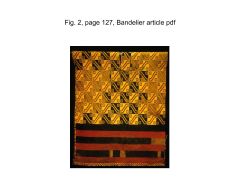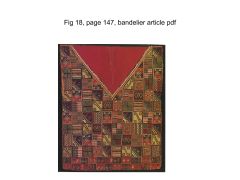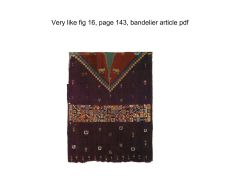![]()
![]()
![]()
Use LEFT and RIGHT arrow keys to navigate between flashcards;
Use UP and DOWN arrow keys to flip the card;
H to show hint;
A reads text to speech;
5 Cards in this Set
- Front
- Back

|
Standardized Inca Checkerboard Tunic (pg. 233) Late Horizon Army uniform Epitomizes Inca graphic, bold, and minimalstic style |
|

|
Fig. 2, pg. 127 Bandelier Article uses of textiles: 1. record keeping (quipu) 2. showing status - common folk = cotton, llama ; royalty = alpaca, bat fur, feathers, vicuna 3. ethnicity, gender 4. diplomatic gesture 5. sacrifices and rituals 6. clothed people, gods, sacrificial and sacred objects, and the Earth itself |
|

|
Inca Royal Tunic (pg. 232) Late Horizon Tocapu = King's robes Covered with tocapus (geometric patterns) Army pattern is seen within the mix showing the king's absolute power over conquest forces Does not keep with standard Inca unit of 10 and has random motifs --> shows that the king was above the law and society because the king is "divine" |
|

|
Fig. 18, pg. 147 Bandelier Article Inca textile aesthetics: 1. color 2. repeated imagery - geometric forms alternating with unadorned areas, abstract, no figuration, motifs restricted - 2 or 3 per cloth 3. areas most decorated: waist, neck, lower border 4. design unit = 10 - standard unit for all Inca textiles (except Tocapu) |
|

|
[similar to] Fig. 16, pg. 143 Bandelier Article Colonial change in design: 1. aggrandizement - increase in Inca status symbols, inclusion of European motifs within traditional design 2. standardization relaxed - more variety, individuality, area of textile previously unadorned are now patterned (lots of patterns!) 3. Tocapu added everywhere, even on the side of embroidery 4. addition to figurative images 5. motifs scattered, no longer in a grid 6. checkerboard and key motifs abandoned 7. European image inclusion is selective and based on pre-colonial ideas 8. colors are more vibrant 9. superficial overlay of colonial influence and design |

